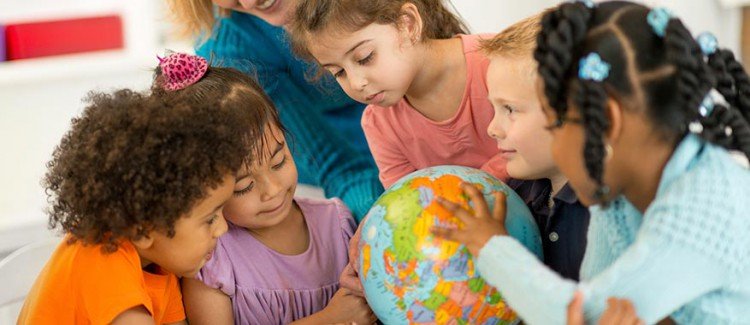Preschool gives children their first sense of community outside the home. Social studies learning begins as children make friends and participate in decision-making in the classroom — then it moves beyond the school into the neighborhood and around the world.
The classroom
Preschool is a safe, caring community with an orderly routine, and each child is valued as an individual. Everything in the classroom lends itself to learning the concepts underlying social studies. When children play pretend, build with blocks, or work together in small groups on class projects, they learn to accept differences, deal with their emotions, and resolve conflicts. They gain confidence as their social skills develop, learning to share, take turns, and practice being both leaders and followers. They develop a sense of personal responsibility by performing a variety of jobs, such as giving out the cups and napkins for snack time or opening the door and turning out the lights when the class leaves the room. Preschoolers also learn community responsibility by cleaning up after projects and taking pride in having a neat classroom. Teachers encourage children to reflect on their experiences and learn from them by asking thought-provoking questions and initiating discussions.
The neighborhood
Teachers help children apply the concepts they learn in their classroom to an understanding of their neighborhood. Children learn to observe their surroundings: the homes, banks, firehouse, police station, restaurants, movie theater, church, synagogue, mosque, senior citizens center, schools, playground, and park. They observe the kinds of stores in the area: groceries, dry cleaners, tailors, barber shops, clothing boutiques, bookstores, and toy stores. They learn what each store sells, where the merchandise comes from, who the customers might be, and why each is important. The teacher may read a book about neighborhoods and discuss similarities and differences between their neighborhood and the one in the book. Later they may make a map of their area.
Class trips
Preschoolers often go to restaurants to learn how meals are prepared and served. They may visit banks, firehouses, police stations, and senior citizen centers. When the children return to their classroom, they discuss their observations and reinforce their learning through play. They may set up a bookstore, grocery store, or bank in the dress-up area and act out the things they have learned.
Holidays
Teachers take advantage of holidays to teach children about their history and to make them aware of different cultural traditions. “We celebrate with songs and stories and craft projects,” says Mary Jane Belt, a preschool teacher from Long Island, N.Y. Children learn about Christopher Columbus and draw pictures of the Santa Maria, Pinta, and Niña or build them out of blocks. At Thanksgiving children talk about the things they are grateful for and act out the first Thanksgiving dinner. On Abraham Lincoln’s birthday, they may build log cabins out of pretzel sticks, recite poems, or listen to stories. On Martin Luther King Jr.’s birthday, they talk about civil rights and learn about the important role King played.
Children also learn to respect the traditions of others by understanding the stories and traditions of religious and ethnic holidays: the Visit of the Three Kings, Christmas, Easter, Passover, Hanukkah, Yom Kippur, Ramadan, and Kwanzaa.
Special visitors
Parents, grandparents, and other adults from the community — such as police officers, firefighters, dentists, doctors, and artists — may be invited to come to the classroom to share stories about their jobs and cultural heritage. A parent who grew up in Portugal or Korea might bring in pictures of traditional costumes, tell a folk tale, or teach the children a dance or song. They might also prepare a favorite recipe for children to taste and explain how it is made and where the ingredients come from. Later the children draw pictures and write stories about the visit to reinforce what they have learned.
The classroom library
Children also learn about their history and other cultures through books they see in the classroom. Teachers read stories about children growing up in Russia, Iceland, Botswana, and on islands in the Caribbean. Children may act out the stories or learn traditional songs and dances. Bill Gordh, director of expressive arts at the Episcopal School in New York City, likes to spin a globe and tell a folk tale from whichever country the children point to.
9 ways to help at home
- Share the values that are important to you. Talk about the ways these values are reflected in your family’s day-to-day life.
- Teach your children family traditions, and make these traditions an important part of their lives.
- Take your children on walks around the neighborhood and talk about local businesses. Find out what they sell and how they contribute to your community. Point out the schools, playgrounds, drugstores, firehouses, police stations, hospitals, and places of worship that are part of the community. Discuss the different cultures that contribute to the community.
- Make maps and drawings of your neighborhood.
- Read books about kids growing up in other lands and cultures.
- If grandparents or friends were born in other countries, invite them to share their experiences and traditions.
- Introduce your children to foods from other countries.
- Collect postcards from other countries and talk about them.
- Play music and folk songs from other countries and cultures.





